|
BRIEF HISTORY OF THE WEYMOUTH HARBOUR TRAMWAY & THE WEYMOUTH QUAY FERRY TERMINAL
With the advent of railway mania, there were a number of schemes to reach Weymouth which would quickly be developed as a port, opening up trade routes to the Channel Islands. The first of these proposals was a line from Bath to Weymouth in 1836. In 1844 a railway from Salisbury to Weymouth was proposed and, in the same year, the Bristol & Exeter Railway proposed a branch to Weymouth via Yeovil from their recently opened line. This line was later cut back to Yeovil when the Wilts, Somerset & Weymouth Railway (with the support of the GWR) proposed a line from a junction with the GWR at Chippenham to Weymouth via Yeovil and Dorchester.
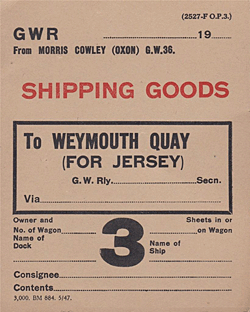 The London & South Western Railway opened their main line from London to Southampton in 1839, and the final scheme was for a line from the LSWR at Southampton via Ringwood and Wimborne to a terminus at Dorchester with a branch to Poole; Bournemouth was not recognised as a town until 1870. Of these schemes, only the Wilts, Somerset & Weymouth Railway (authorised 30 June 1845) and the Southampton & Dorchester Railway (authorised 21 July 1845) were built. The London & South Western Railway opened their main line from London to Southampton in 1839, and the final scheme was for a line from the LSWR at Southampton via Ringwood and Wimborne to a terminus at Dorchester with a branch to Poole; Bournemouth was not recognised as a town until 1870. Of these schemes, only the Wilts, Somerset & Weymouth Railway (authorised 30 June 1845) and the Southampton & Dorchester Railway (authorised 21 July 1845) were built.
Construction of the S&D proceeded rapidly, and the main line and Poole branch opened to passenger traffic on 1 June 1847. Construction of the broad gauge WS&WR was not going so well, however, with continual delays owing to lack of funds. The line was eventually completed to Westbury in 1848 but, by this time, the company was virtually bankrupt; the GWR was forced to step in, taking over both the assets and liabilities and allowing construction to continue. The line did not reach Weymouth until 20 January 1857, and powers to extend the line to Weymouth Quay were allowed to lapse. There was a junction between the two lines at Dorchester with mixed gauge rails laid into Weymouth allowing both the GWR and the LSWR to reach the town.
As expected, the railway quickly brought prosperity to Weymouth, which rapidly developed as a both a cross-channel port and holiday resort. Weymouth station was to the north of the town and a mile from the harbour, and it was soon clear that an extension to the quay was desirable, but this would have to wait until construction of the Portland branch.
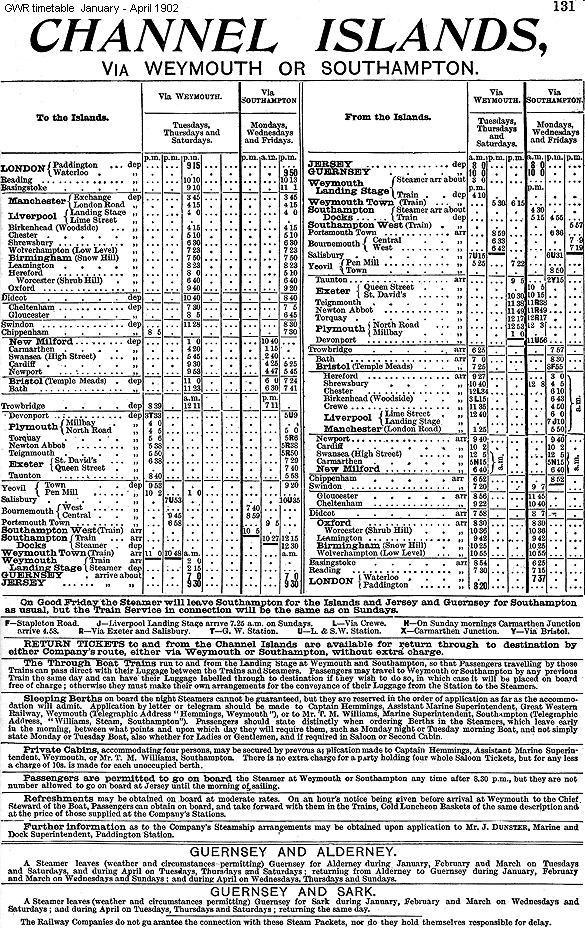
The Weymouth & Portland Railway Act received the Royal Assent on 30 June 1862. Sufficient land was purchased to allow for the track to be doubled at a future date, and construction started in December 1862 with the intention of completing the line by January 1864. The Marsh embankment
was completed by the end of February 1864 with the first train running over the entire length of the line on 5 May. This consisted of a broad gauge engine which hauled standard gauge wagons conveying company personnel.
The Board of Trade inspection was carried out by Col Yolland on 19 May 1864. The inspector’s report was particularly critical of the two viaducts which he considered to be ‘very unsatisfactory’ for many reasons. Col Yolland was equally scathing about the signalling arrangements at Portland Junction in Weymouth, citing numerous other areas where improvements were required.
.gif) Permission to open the line was refused and, after some remedial work had been completed, a second inspection took place on 6 August 1864. The inspector noted some strengthening of the Permission to open the line was refused and, after some remedial work had been completed, a second inspection took place on 6 August 1864. The inspector noted some strengthening of the
viaducts but many of the other necessary improvements had not been carried out, including the
signalling arrangements at Portland Junction which were still wholly inadequate; once again the
inspector refused to sanction the opening of the line. It was soon clear that the GWR, LSWR and the local company were in complete disagreement about the provision of passenger facilities at Weymouth. The Weymouth & Portland board was of the opinion that it was not obliged to provide a separate station on the new line, while the LSWR did want a separate branch station to be paid for by the W&P. The GWR was happy to use its existing station but demanded payment which was resisted by the W&P board. Disagreements continued for over a year while the line lay idle.
Eventually the dispute went to arbitration. The ruling was that the W&P should use the existing station, for which they should pay the GWR £2,600; they were also ordered to pay the GWR for land and improvements to the junction between the branch and the main line in order to pass the next inspection.
Despite this ruling, the three companies were still unable to agree over the exact detail of the new arrangements. The Weymouth Quay tramway, which was now complete and ready for opening with horse-drawn traffic, was unable to open as it was an integral part of the Portland line and, for
legal reasons, could not be opened before the branch.
The three parties eventually settled their longstanding dispute, and the Board of Trade sanctioned the opening of the line. Goods traffic started on 9 October 1865, and the Portland branch finally opened to passenger traffic with little ceremony on Monday 16 October.
.gif) The first ferry service between Weymouth and the Channel Islands was launched in 1794 with a packet steamer service. Although this was originally for trading between England and the Channel Islands, it also gave rise to many Dorset families settling in the Channels Islands. The Weymouth Harbour tramway also opened on 16 Oct 1865 running from a junction with the Portland branch through the streets adjacent to the Backwater and the harbour, to the quay. It was constructed to mixed gauge and jointly available to the LSWR and the GWR. However the LSWR was not involved directly with the day to day operation of the quay line and to all intents and purposes it was a GWR line. Initially the tramway handled only goods traffic and was worked by horses until 1880. In 1889 the GWR took over the ferry service, with the first passenger train running on 4 August 1889 when the tramway was extended to the new ferry terminal allowing travellers to reach the Channel Island ferries which operated from the Quay. The GWR remained the sole operator of the service until 1948 The first ferry service between Weymouth and the Channel Islands was launched in 1794 with a packet steamer service. Although this was originally for trading between England and the Channel Islands, it also gave rise to many Dorset families settling in the Channels Islands. The Weymouth Harbour tramway also opened on 16 Oct 1865 running from a junction with the Portland branch through the streets adjacent to the Backwater and the harbour, to the quay. It was constructed to mixed gauge and jointly available to the LSWR and the GWR. However the LSWR was not involved directly with the day to day operation of the quay line and to all intents and purposes it was a GWR line. Initially the tramway handled only goods traffic and was worked by horses until 1880. In 1889 the GWR took over the ferry service, with the first passenger train running on 4 August 1889 when the tramway was extended to the new ferry terminal allowing travellers to reach the Channel Island ferries which operated from the Quay. The GWR remained the sole operator of the service until 1948
 The ferry terminal was initially shown as Weymouth Landing Stage in the Railway Clearing House station handbook. In 1892 it was listed as Weymouth Quay New Pier and in 1895, 1904 and 1938 there are separate entries for Weymouth Landing Stage and Weymouth Quay. The 1956 handbook has one entry for Weymouth Quay. A long platform was constructed on the pier alongside the ferry terminal with a separate goods loading stage at Custom House Quay which was just before the pier. The ferry terminal was initially shown as Weymouth Landing Stage in the Railway Clearing House station handbook. In 1892 it was listed as Weymouth Quay New Pier and in 1895, 1904 and 1938 there are separate entries for Weymouth Landing Stage and Weymouth Quay. The 1956 handbook has one entry for Weymouth Quay. A long platform was constructed on the pier alongside the ferry terminal with a separate goods loading stage at Custom House Quay which was just before the pier.
As freight traffic grew, several sidings and loops were added to the main line to serve harbour-side businesses. The town bridge was rebuilt in 1930 with the tramway initially routed through the northern arch. Between 1931 and 1933 a second track and platform were provided at the pier. Between 1938 and 1939 the tight curve between the Backwater and harbour was replaced with a new curve on a newly infilled section of the quayside, and the tramway was relocated to the outer arch of the bridge, where it remains today; the old route was retained as a loop. During WW2 a new ferry terminal was built near the Town Bridge but it was never used and subsequently demolished. A third track and platform was added in 1961, but this was to be short-lived as it was taken out of use in 1973 when the track was shortened for use as a fuel oil siding.
Passenger trains were withdrawn from 6 September 1939 at the start of WW2 with the station reopening on 25 July 1940 for specials such as refugee trains. It was fully reopened on 15 June 1946. Cargo traffic was also suspended on 1 July 1940 following German occupation of the Channel Islands, restarting on 18 September 1945
The 1889 ferry terminal was replaced with a new structure in the late 1960s. Regular goods traffic ceased on 26 February 1972 because there was insufficient space to handle the growing container traffic. The service was transferred to Southampton, although fuel oil was transported to a facility at the pier with two trains a week until September 1983. The oil was for bunkering ships in the harbour. In March 1983 there was a trial run of a DMU prior to the introduction of a regular service from Bristol during the summers of 1984/85. Regular passenger services ceased in September 1987.
 In 1997 there were some experiments with a flywheel-powered vehicle. These are lightweight trams and railcars that use flywheel energy storage to store energy for traction, allowing electric systems to operate without overhead wires or third rails; the railcars are fuelled by small gas, diesel or hydrogen engines, offering very high energy efficiency and very low emissions. These experiments did not result in permanent traffic on the tramway. In 1997 there were some experiments with a flywheel-powered vehicle. These are lightweight trams and railcars that use flywheel energy storage to store energy for traction, allowing electric systems to operate without overhead wires or third rails; the railcars are fuelled by small gas, diesel or hydrogen engines, offering very high energy efficiency and very low emissions. These experiments did not result in permanent traffic on the tramway.
After the last withdrawal of regular passenger service the tramway was still regularly visited by railtours, and the last use of the tramway was by the Pathfinder Tours ‘The Way-Farer’ on 2 May 1999. At this time it was the last main-line street tramway in Britain.
At Weymouth Junction the tramway’s own locomotives were attached to incoming boat trains; these were Class 1366 pannier tanks from 1935 until 1972 when haulage was taken over by Drewery diesel shunters. These lasted until 1972 when Class 33 diesels took on the role until the end of regular traffic. Trains operating over public thoroughfare tramway without escort are required to be fitted with warning equipment for the general public. During operation of services by British Rail Class 33 locomotives, two warning units were built and housed in a cabinet at the track side entrance to the tramway at the throat of Weymouth yard. This equipment comprised a yellow box which fitted on a lamp bracket on the cab front, and it had an amber rotating beacon and bell which served to warn thoroughfare users. The bell did not ring continuously but could be controlled by the train driver.

Each member of Class 33/1 and all TC stock had a small socket where the bell/beacon units plugged in to draw power from the train systems. Trains for the quay would halt at the station throat, where the warning equipment was attached and then tested by the train guard. In addition, trains on the tramway were 'walked' by railway staff with flags, clearing the route of people and badly parked cars all the way between the points at which the tramway reverted to conventional track at the quay station and King Street crossing into Weymouth yard. This was to comply with 1880 regulations which were still in force. On arrival at the quay terminus the guard would move the warning equipment to the other end of the train in readiness for the return journey.
 The tramway still exists, in remarkably good condition, and could in theory be used again, though the short reserved section from King Street to the junction is somewhat overgrown. Although no traffic has run over the tramway since 1999 it has not officially been closed. The line was The tramway still exists, in remarkably good condition, and could in theory be used again, though the short reserved section from King Street to the junction is somewhat overgrown. Although no traffic has run over the tramway since 1999 it has not officially been closed. The line was
designated 'Out of Use (temporary)' for a period of 2 years by Network Rail on 15 January 2007, and again on 1 April 2009. In January 2009 it was reported that Weymouth and Portland Borough Council wished to remove the tramway, and that Network Rail had confirmed it had no wish for its retention.
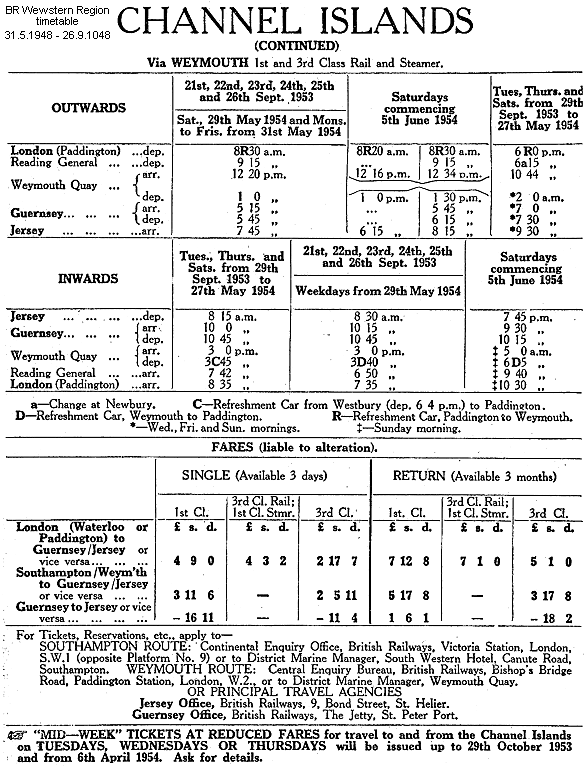
 In 2009, Weymouth & Portland Borough Council voted to acquire the 150-year-old seafront track from Network Rail in a £50,000 deal. It was part of a £135m plan to redevelop the Weymouth Pavilion site and build a new hotel and ferry terminal in time for the 2012 Olympics. One idea was to incorporate the track into a light railway system to serve spectators travelling to the sailing events on Portland. The scheme was cancelled in September 2009 when funding fell through because the firm involved went into liquidation. In 2009, Weymouth & Portland Borough Council voted to acquire the 150-year-old seafront track from Network Rail in a £50,000 deal. It was part of a £135m plan to redevelop the Weymouth Pavilion site and build a new hotel and ferry terminal in time for the 2012 Olympics. One idea was to incorporate the track into a light railway system to serve spectators travelling to the sailing events on Portland. The scheme was cancelled in September 2009 when funding fell through because the firm involved went into liquidation.
At the time Weymouth Councillor Howard Legg said, ‘the railway line would either be scrapped, preserved for future use or left as it is. Tracks to the quayside remain and the route is still regarded as viable. They may possibly be used in the future for some form of leisure attraction.’
There are plans to fill in the gaps between the rails along the quays. Dorset County Council wants to make the road safer for cyclists by filling the gaps with a sand and tar mix that could be removed if the tracks were operational again in the future. There have been several accidents caused by the tracks over the years, and cyclists and motor-cyclists are particularly vulnerable.
 The ferry terminal was closed in February 2011 when it was declared unsafe due to structural problems, and Condor Ferries moved its Channel Island sailings from Weymouth to Poole. Repairs started in December 2012 and after completion fast ferry services to the Channel Islands and France returned to Weymouth on 17 July 2013. Condor Ferries now operate between Weymouth and Guernsey, Jersey and St Malo in Brittany. The ferry terminal was closed in February 2011 when it was declared unsafe due to structural problems, and Condor Ferries moved its Channel Island sailings from Weymouth to Poole. Repairs started in December 2012 and after completion fast ferry services to the Channel Islands and France returned to Weymouth on 17 July 2013. Condor Ferries now operate between Weymouth and Guernsey, Jersey and St Malo in Brittany.
Tickets from Michael Stewart except 0483 & 0094 Brian Halford. Route map drawn by Alan Young, Bradshaw & BR timetable from Chris Totty.
The Weymouth Harbour Tramway was always a popular subject for amateur filmmakers. A varied selection of films can be found on YouTube, the best if them is Fred Ivey's 10 minute film of the tramway in operation on 12 December 1994. This includes cars being removed as the train progresses along the tramway. Other films are listed below:
Film 2: 1966 1½ minutes
Film 3: August 1975 1½ minutes
Film 4 : 1987 2 minutes
Film 5: c1980s 3 ½ minutes
Film 6 : Hertfordshire Rail Tours 'Weymouth Quay Shuttles' - 3 April 1993 1½ minutes
Film 7 : Hertfordshire Rail Tours 'Weymouth Quay Shuttles' - 3 April 1993 8 minutes
Film 8 : Pathfinder Tours 'The Itchen-Piddle' - 6 November 1993 8 ½ minutes
Film 9 : Pathfinder Tours 'The Itchen-Piddle' - 6 November 1993 9 ½ minutes
Film 10 : Pathfinder Tours 'The Itchen-Piddle' - 6 November 1993 3 ½ minutes
Film 11 : Pathfinder Tours 'The Itchen-Piddle' - 6 November 1993 9 ½ minutes
Film 12: Ocean Liner Express - 5 June 9994 4 ½ minutes
Film 13: Ocean Liner Express - 5 June 9994 6 ½ minutes
Film 14:
Ocean Liner Express - 5 June 9994 5 minutes
Film 15: Ocean Liner Express - 5 June 9994 3 minutes
Film 16: Pathfinder Tours ‘The Way-Farer’ - 2 May 1999 6 minutes
Sources:
To see other stations on the Portland & Easton branch click on the station name: Weymouth, Melcombe Regis, Westham Halt, Rodwell, Sandsfoot Castle Halt, Wyke Regis Halt, Portland 1st, Portland 2nd, Portland Hospital,
Portland Dockyard & Easton |


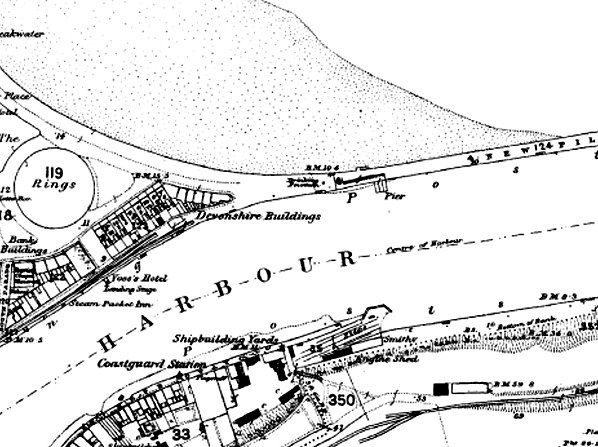
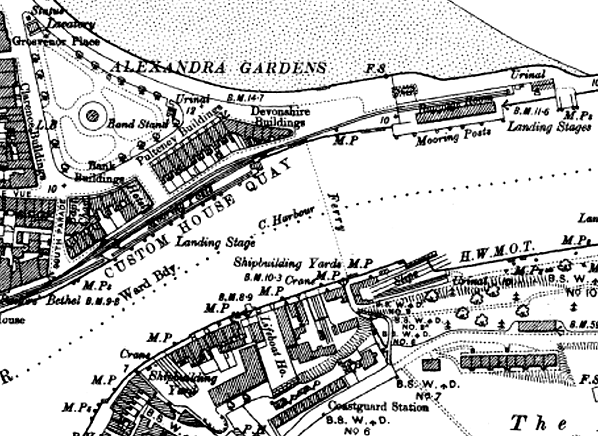
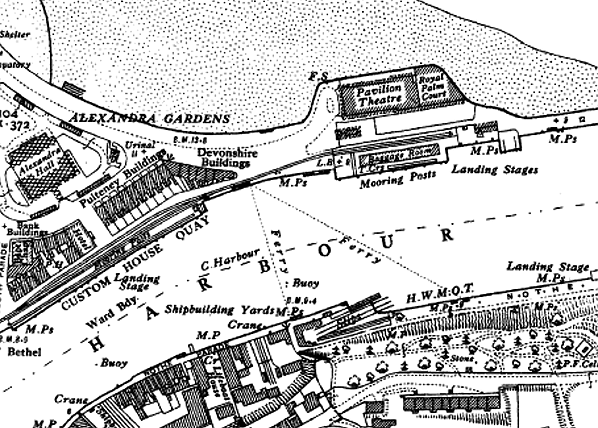
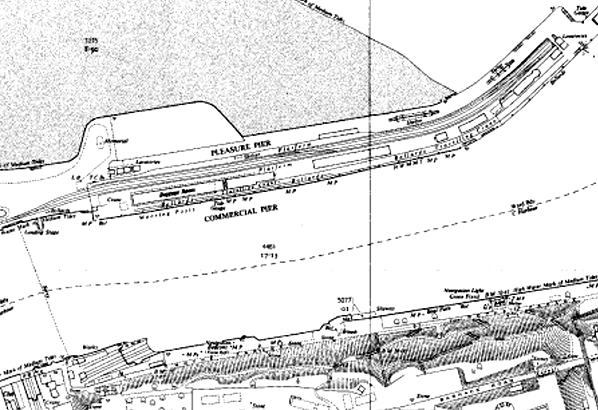
quay_old7.jpg)
quay_old1.jpg)
quay_old5.jpg)
quay_old18.jpg)
quay_old17.jpg)
quay_old24.jpg)
quay_old16.jpg)
quay_old23.jpg)
quay_old29.jpg)
quay_old15.jpg)
quay_old12.jpg)
quay1.jpg)
 The London & South Western Railway opened their main line from London to Southampton in 1839, and the final scheme was for a line from the LSWR at Southampton via Ringwood and Wimborne to a terminus at Dorchester with a branch to Poole; Bournemouth was not recognised as a town until 1870. Of these schemes, only the Wilts, Somerset & Weymouth Railway (authorised 30 June 1845) and the Southampton & Dorchester Railway (authorised 21 July 1845) were built.
The London & South Western Railway opened their main line from London to Southampton in 1839, and the final scheme was for a line from the LSWR at Southampton via Ringwood and Wimborne to a terminus at Dorchester with a branch to Poole; Bournemouth was not recognised as a town until 1870. Of these schemes, only the Wilts, Somerset & Weymouth Railway (authorised 30 June 1845) and the Southampton & Dorchester Railway (authorised 21 July 1845) were built.
.gif) Permission to open the line was refused and, after some remedial work had been completed, a second inspection took place on 6 August 1864. The inspector noted some strengthening of the
Permission to open the line was refused and, after some remedial work had been completed, a second inspection took place on 6 August 1864. The inspector noted some strengthening of the .gif) The first ferry service between Weymouth and the Channel Islands was launched in 1794 with a packet steamer service. Although this was originally for trading between England and the Channel Islands, it also gave rise to many Dorset families settling in the Channels Islands. The Weymouth Harbour tramway also opened on 16 Oct 1865 running from a junction with the Portland branch through the streets adjacent to the Backwater and the harbour, to the quay. It was constructed to mixed gauge and jointly available to the LSWR and the GWR. However the LSWR was not involved directly with the day to day operation of the quay line and to all intents and purposes it was a GWR line. Initially the tramway handled only goods traffic and was worked by horses until 1880. In 1889 the GWR took over the ferry service, with the first passenger train running on 4 August 1889 when the tramway was extended to the new ferry terminal allowing travellers to reach the Channel Island ferries which operated from the Quay. The GWR remained the sole operator of the service until 1948
The first ferry service between Weymouth and the Channel Islands was launched in 1794 with a packet steamer service. Although this was originally for trading between England and the Channel Islands, it also gave rise to many Dorset families settling in the Channels Islands. The Weymouth Harbour tramway also opened on 16 Oct 1865 running from a junction with the Portland branch through the streets adjacent to the Backwater and the harbour, to the quay. It was constructed to mixed gauge and jointly available to the LSWR and the GWR. However the LSWR was not involved directly with the day to day operation of the quay line and to all intents and purposes it was a GWR line. Initially the tramway handled only goods traffic and was worked by horses until 1880. In 1889 the GWR took over the ferry service, with the first passenger train running on 4 August 1889 when the tramway was extended to the new ferry terminal allowing travellers to reach the Channel Island ferries which operated from the Quay. The GWR remained the sole operator of the service until 1948 The ferry terminal was initially shown as Weymouth Landing Stage in the Railway Clearing House station handbook. In 1892 it was listed as Weymouth Quay New Pier and in 1895, 1904 and 1938 there are separate entries for Weymouth Landing Stage and Weymouth Quay. The 1956 handbook has one entry for Weymouth Quay. A long platform was constructed on the pier alongside the ferry terminal with a separate goods loading stage at Custom House Quay which was just before the pier.
The ferry terminal was initially shown as Weymouth Landing Stage in the Railway Clearing House station handbook. In 1892 it was listed as Weymouth Quay New Pier and in 1895, 1904 and 1938 there are separate entries for Weymouth Landing Stage and Weymouth Quay. The 1956 handbook has one entry for Weymouth Quay. A long platform was constructed on the pier alongside the ferry terminal with a separate goods loading stage at Custom House Quay which was just before the pier. In 1997 there were some experiments with a flywheel-powered vehicle. These are lightweight trams and railcars that use flywheel energy storage to store energy for traction, allowing electric systems to operate without overhead wires or third rails; the railcars are fuelled by small gas, diesel or hydrogen engines, offering very high energy efficiency and very low emissions. These experiments did not result in permanent traffic on the tramway.
In 1997 there were some experiments with a flywheel-powered vehicle. These are lightweight trams and railcars that use flywheel energy storage to store energy for traction, allowing electric systems to operate without overhead wires or third rails; the railcars are fuelled by small gas, diesel or hydrogen engines, offering very high energy efficiency and very low emissions. These experiments did not result in permanent traffic on the tramway. 
 The tramway still exists, in remarkably good condition, and could in theory be used again, though the short reserved section from King Street to the junction is somewhat overgrown. Although no traffic has run over the tramway since 1999 it has not officially been closed. The line was
The tramway still exists, in remarkably good condition, and could in theory be used again, though the short reserved section from King Street to the junction is somewhat overgrown. Although no traffic has run over the tramway since 1999 it has not officially been closed. The line was 
 In 2009, Weymouth & Portland Borough Council voted to acquire the 150-year-old seafront track from Network Rail in a £50,000 deal. It was part of a £135m plan to redevelop the Weymouth Pavilion site and build a new hotel and ferry terminal in time for the 2012 Olympics. One idea was to incorporate the track into a light railway system to serve spectators travelling to the sailing events on Portland. The scheme was cancelled in September 2009 when funding fell through because the firm involved went into liquidation.
In 2009, Weymouth & Portland Borough Council voted to acquire the 150-year-old seafront track from Network Rail in a £50,000 deal. It was part of a £135m plan to redevelop the Weymouth Pavilion site and build a new hotel and ferry terminal in time for the 2012 Olympics. One idea was to incorporate the track into a light railway system to serve spectators travelling to the sailing events on Portland. The scheme was cancelled in September 2009 when funding fell through because the firm involved went into liquidation. The ferry terminal was closed in February 2011 when it was declared unsafe due to structural problems, and Condor Ferries moved its Channel Island sailings from Weymouth to Poole. Repairs started in December 2012 and after completion fast ferry services to the Channel Islands and France returned to Weymouth on 17 July 2013. Condor Ferries now operate between Weymouth and Guernsey, Jersey and St Malo in Brittany.
The ferry terminal was closed in February 2011 when it was declared unsafe due to structural problems, and Condor Ferries moved its Channel Island sailings from Weymouth to Poole. Repairs started in December 2012 and after completion fast ferry services to the Channel Islands and France returned to Weymouth on 17 July 2013. Condor Ferries now operate between Weymouth and Guernsey, Jersey and St Malo in Brittany.quay_old22.jpg)

 Home Page
Home Page